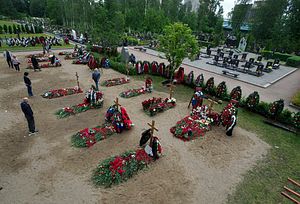A fire aboard a Russian submarine that killed 14 sailors earlier this month could have caused a catastrophe on a global scale if not for the heroism of the crew, Reuters reported on July 8, citing a Russian media report that quotes a senior Russian Navy official.
“They all shared one and the same fate – to save the lives of their comrades, to save their vessel and to prevent a catastrophe of global proportions at the cost of their own lives,” Captain Sergei Pavlov, an aide to the Russian Navy’s commander, was quoted as saying by local outlet Fontanka at the private funeral of the sailors held last Saturday in St. Petersburg.
It is unclear from Pavlov’s comments how the fire could have resulted in a global catastrophe. Russian Defense Minister Sergei Shoigu insisted in an earlier statement that the nuclear reactor on board the submarine had been completely sealed off from the fire. “The main cause of the incident has been established: it was a fire in the battery compartment and then it spread,” Shoigu said in a statement published by the Kremlin on July 3.
In a conference call with reporters, Kremlin spokesman, Dmitry Peskov, said there were no indications that the accident could have caused a larger catastrophe. “As for the reactor, there are no problems with that,” he is quoted as saying by Bloomberg News on July 8. Peskov also insisted that the submarine type involved in the accident will remain “absolutely classified.” As I reported on July 3:
The accident reportedly either occurred on board the nuclear-powered Project 10831 Losharik (AS-12), one of the Russian Navy’s “special projects” spy subs, or inside the larger modified Project 667BDRM Delfin-class (Delta-IV) nuclear-powered submarine BS-64 Podmoskovye. According to one Russian media report, the accident occurred aboard a submersible that its mothership, the Losharik, had launched, although it is unclear whether the Losharik has the capability to do so.
The Losharik and Podmoskovye are both operated by the Russian Navy on behalf of the Main Directorate Deep Sea Research (GUGI). GUGI reportedly maintains one of the world’s largest fleet of spy subs with the total number estimated at around eight. GUGI deploys the subs for intelligence gathering and special operations missions.
The accident reportedly took place in the Barents Sea on July 1. Shoigu gave the order on July 3 to immediately start repairing the submarine for future operations. “While visiting the facility, Sergei Shoigu set the task to the Fleet’s command to as soon as possible work out and implement measures jointly with the industry’s representatives to repair the submersible and bring it into operation again,” a Russian Ministry of Defense press release states.
Russian President Vladimir Putin awarded Russia’s highest honors to the 14 sailors who died.

































